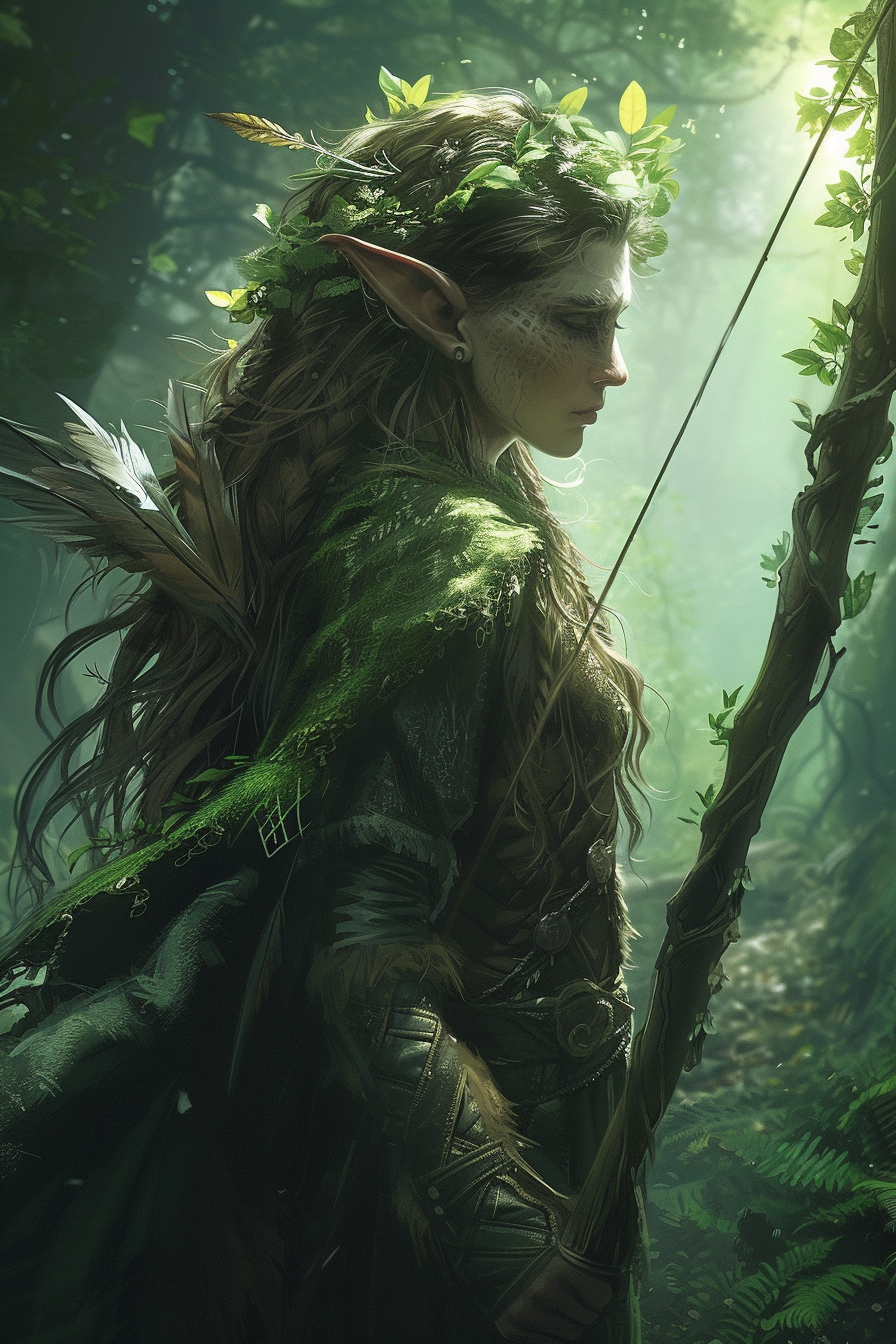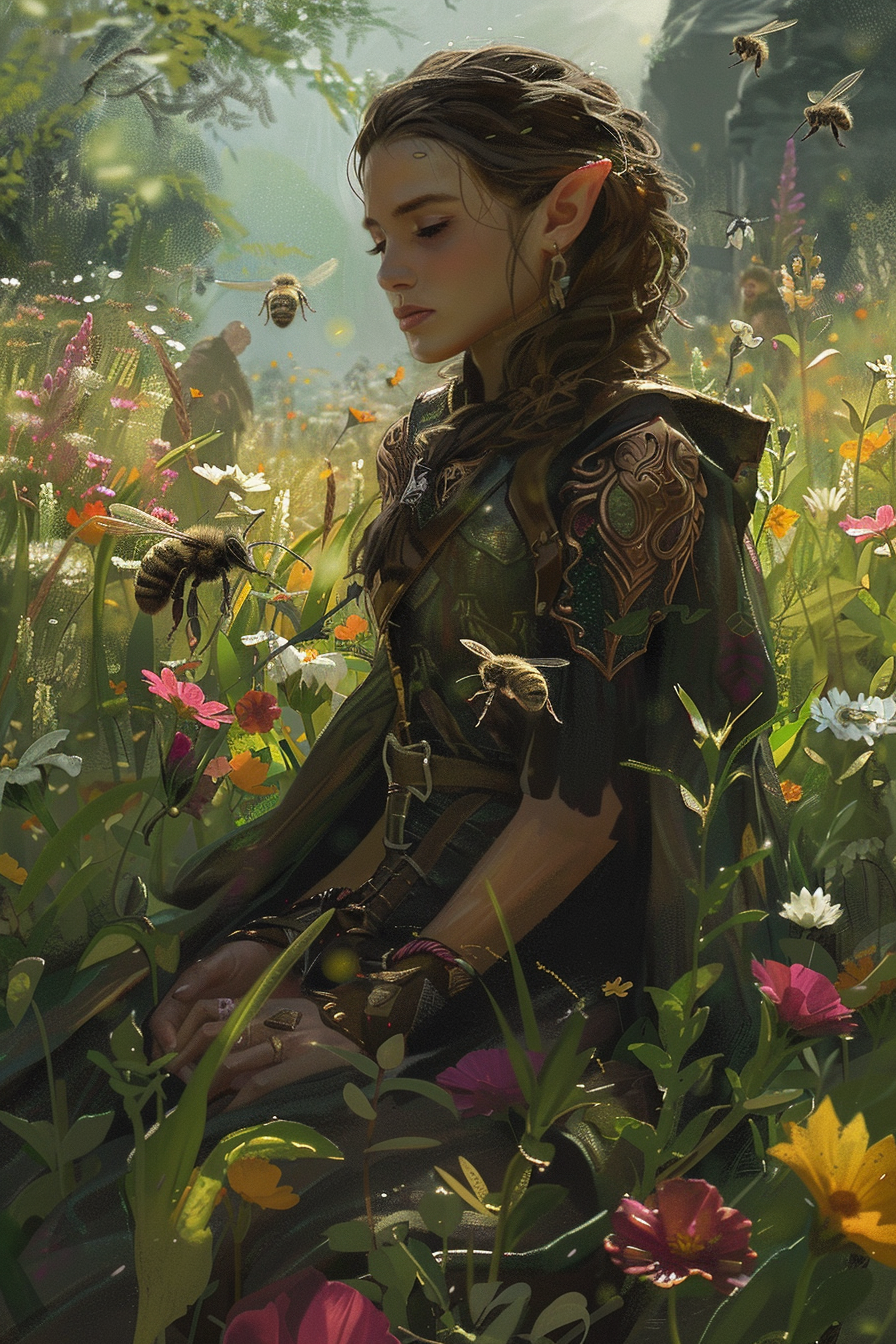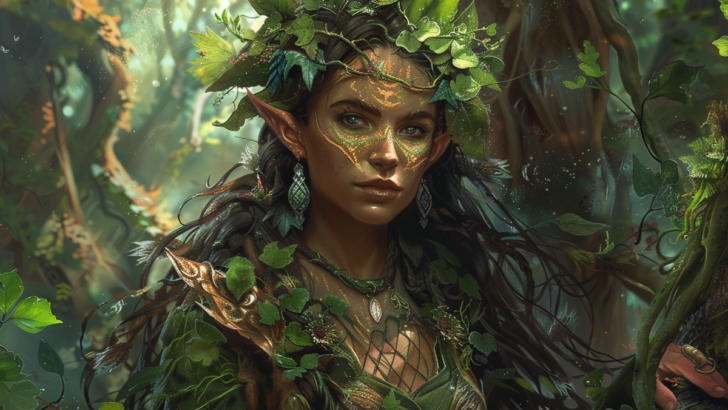Elf Druids are mystical peoples of the woods, attuned to the flow of nature and the magic that flows through it. They have a deep connection to the earth and its creatures and can call upon the elements to aid them in battle or heal their wounds.
The gentle demeanor of Elf Druids is no weakness, as they hold a fierce loyalty to their forest home and a deep understanding of its secrets, being capable of commanding the very trees and stones to rise up against their enemies.
If you find yourself wandering through the woods and happen upon an Elf Druid, you will do well to tread lightly in their presence.
Creating an Elf Druid

Elves
Elves are magical beings, omitting otherworldly grace and living in places of exquisite beauty. Their homes are found in ancient forests or silvery belfries glittering with faerie brilliance.
Soft music constantly meanders through the air, with serene fragrances riding upon the breeze. Elves have a great love for art and its craft, music, poetry, nature, and magic.
| Skin | They have skin similar to that of humans yet also incorporate hues of copper, bronze, near bluish-white, or polished obsidian |
| Hair (Elves don’t have facial hair and little body hair) | Green, blue, stark white, or pale yellow |
| Eyes | Liquidy gold and silver, along with pale white, pink, red, and blue |
| Nose | Similar to humans, yet very petite and beautiful |
| Mouth | They have human-like teeth, kept well, and always pearly white |
Note: These features can be slightly changed or modified if some variations don’t fit your character.
Elf Subraces
Elves have 11 subraces to choose from, excluding those from Plant Shift. Each subrace is unique and can provide a different playstyle than the next, leading to near-infinite possibilities.
Dark Elf (Drow) – Dark Elves are mostly known as demon-worshipping pillagers living in the Underdark. They are depraved, worshipping Lolth, a goddess who spreads evil and hatred.
Dark Elves fight best in the dark, using various magical spells and ranged weapons to attack their enemies.
High Elf – High Elves are extremely clever and always have a mastery of at least the basics of the mystical arts. These elves often speak one extra language and have the potential to become extremely powerful spellcasters.
Wood Elf – Wood Elves have naturally keen senses and unmatched intuition. They are at home in forests and move quickly yet stealthily through them – with their hands never too far from the bows.
Sea Elf – Sea Elves fell in love with the sea when they came to their world. They have explored many treacherous waters and mastered swimming and the use of a trident.
Pallid Elf – Pallid Elves are insightful people with mystical backgrounds. They excel at investigations and have access to powerful control spells.
Shadar-Kai – Shadar-Kai exist between life and death, serving the Raven Queen and emerging from the Shadowfell.
Because of their strange state, Shadar-Kai are resistant to Necrotic damage, being able to teleport short distances and temporarily granting resistance to all damage (at level 3).
Mark of Shadow Elf – Mark of the Shadow Elves are masters of illusion and disguise, often becoming deadly assassins, feeble spies, or cunning thieves. Their magical abilities also make them excellent spellcasters.
Avariel Elf (UA) – Avariel Elves possess wings but are extremely rare, as wars between them and dragons reduced their numbers.
These Elves do not differ from regular elves; their only difference is that they can fly and also speak, read, and write Auran, their native tongue.
Grugach Elf (UA) – Grugach Elves prefer their solace, living deep within forests and seeking animals for companionship, even regarding other Elves as suspicious.
Many of these Elves become druids and rangers, defending their land against those who would impose on it.
Note: Grugach Elves do not understand Common; they instead understand Sylvan.
Eladrin (MToF) – Eladrin Elves are native to the Feywilds, associating themselves with a single season or physically transforming at the passing of each new season, which also changes their personalities.
These Elves often become druids as their love for nature keeps them alive.
Eladrin (DMG) – Eladrin Elves are strongly tied to nature, living in the Feywilds but occasionally traversing into the Material Plane. Most of these Eladrin have proficiency with bows and swords, generally becoming rangers or rogues.
Druid Class Features
Hit Points
| Hit Dice | 1d8 per Druid level |
| HP at level 1 | 8 + Constitution modifer |
| HP at Higher levels | 1d8 (or 5) + Constitution modifier per Druid level after level 1 |
Proficiencies
| Armor | Light armor, Medium armor, Shields (Druids will not wear armor or shields made from metal) |
| Weapons | Clubs, Daggers, Darts, Javelins, Maces, Quarterstaffs, Scimitars, Sickles, Slings, Spears |
| Tools | Herbalism kit |
| Saving Throws | Intelligence, Wisdom |
| Skills | Choose two – Arcana, Animal Handling, Insight, Medicine, Nature, Perception, Religion, and Survival |
Druid Circles
Upon reaching level 3, you’ll have access to 7 different Druid circles, all having their playstyles – but you’ll have to find one that best fits your character.
Dreams – Members of the Circle of Dreams have strong ties to the Feywild. They have a duty to protect the natural world, meaning they’re in an alliance with the good-aligned fey.
These Druids are masters at magical remedies, using them to mend wounds, bring joy to those unwilling to live on and have them find peace.
Land – Circle of the Land Druids are keepers of knowledge passed down through oral tradition. They whisper secrets around standing stones and serve as advisors to communities holding on to the Old Faith.
The magic they wield is influenced by the land they were initiated, giving them an undying link to that place.
Moon – Druids belonging to the Circle of the Moon are fierce natural guardians, living so deep within the wilderness that months can pass before seeing another humanoid.
These Druids can prowl as a giant feline, fly through the sky as a bird of prey or act as the guardian bear of the forest.
Shepard – Circle of the Shepard Druids commune with nature spirits – especially those of beasts and fey – calling upon them for aid.
They protect animals rather than themselves, living their days in the wilderness, enjoying the company of the animals they hold dear. The spirits of the wilderness always follow their shepherds.
Spores – Members of the Circle of Spores find beauty in decay, seeing that every death leads to new life and only being a change of state.
These Druids have complex relations with the undead, considering some as allies. However, they don’t permit undead to change the cycle they hold dear, thwarting those who try to violate it.
Stars – Circle of the Stars Druids understand the power of the cosmos, seeking to harness its powers and reveal its mysteries.
They record constellations, documenting their effects on the world and constructing monoliths to hold their knowledge, protected even against powerful cataclysms.
Wildlife – Druids belonging to the Circle of Wildfire see destruction as the precursor to creation.
They bond with primal spirits, unlocking their creative and destructive power and using it to create devastating attacks or give life to those who need it most.
Combining Druid With Elf

Determining Your Druid Subclass
Choosing your ideal subclass is subjective, but if your objective is optimization, try understanding what your character wants to do and what stats fit best with their subclass.
| Class | Role |
| Dreams | Support/Utility Caster |
| Land | Controller/Support/Utility Caster |
| Moon | Striker/Support |
| Shepherd | Support |
| Spores | Blaster/Support |
| Stars | Healer/Support |
| Wildfire | Blaster/Controller/Healer |
Optimal Elf Subrace
Elves have a natural bonus to Dexterity (2) which is not particularly important to Druids.
The Wood Elf and Pallid Elf subraces have bonus Wisdom (1), affecting a Druid’s proficient saving throws and their spellcasting ability modifier.
Your Elf Druid Background
You need to think of a background that embraces the core values of an Elf yet leads you down the path of becoming a Druid.
Start by asking yourself some basic questions: Where were they born, and where did they come from? Do they have any goals, bonds, or ideals, and what are their flaws? Where do they belong in social circles and society as a whole? What inspires them?
Place of Birth
Think of the environment an Elf Druid grew up in and how it affected them physically and emotionally and eventually shaped their view of the world.
Try to make their place of birth and upbringing correspond with their personality traits, ideals, bonds, and flaws – this will truly bring their character alive.
Note: The birthplaces of races are usually mentioned in the Player’s Handbook or some of its expansion books.
Characteristics and Personality Traits
Elves are angelic creatures, often known for their fairness and gentle disposition; however, some shun those traits, becoming entirely different – something you should strive for when creating your character.
Elf Druid Examples:
- I’m driven by my wanderlust which led me away from home.
- I have a lesson for each situation drawn from observing nature.
Ideals, Bonds, and Flaws
Ideal – Express one ideal that is a driving force in an Elf Druid’s life – their conviction, ethical principle, and moral standing (probably something about nature).
The natural world is more important than any and all the constructs of civilization.
Bonds – Think of a single bond that your Elf Druid has to an event, person, or place. Bonds will tie them to their background and can inspire bravery or stimulate memories driving them against their ideals.
I idolize a renowned hero of the old tales, often measuring my deeds against that person.
Flaws – Choose a single flaw for an Elf Druid – their unhealthy compulsion, greatest fear/weakness, or most vile vice.
I have a weakness for the city’s vices, especially hard drink.
Inspiration
The DM can use inspiration to reward you for playing according to your bond, personality traits, ideals, and flaw.
I enjoy conversations with new people.
Note: If you’re struggling to create your background or just don’t want to think, the Player’s Handbook has well-thought-through backgrounds that you can use for your character or use as a mold.
Supplies and Gear For Elf Druids
Druids start with the following equipment, together with the equipment from their background. Choosing equipment based on your situation and your character’s proficiencies is the easiest way to go about things.
- (a) Wooden shield or (b) Any simple weapon
- (a) Scimitar or (b) Any simple melee weapon
- Leather armor, an explorer’s pack, and a druidic focus
You can decide how your character came about these goods – whether they stole, inherited, or purchased them some time back – adding to your character’s background.
Note: You can also use your starting wealth to buy equipment (2d4 x 10 GP for Druids).
Final Thoughts
Elf Druids embody natural beauty, having a love for everything in nature, and caring for other races.
A party looking for an efficient Healer or Support should try to find an Elf Druid at all costs.
You might also be interested in the following:


Half-Elf Ranger 5e D&D Guide
Monday 4th of December 2023
[…] Elf Druid […]
Half-Elf Rogue 5e D&D Guide
Monday 4th of December 2023
[…] Elf Druid […]
Half-Elf Sorcerer 5e D&D Guide
Friday 10th of November 2023
[…] Elf Druid […]
Half-Elf Barbarian 5e D&D Guide
Monday 26th of June 2023
[…] Elf Druid […]